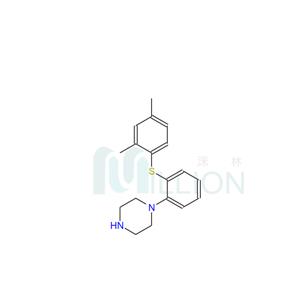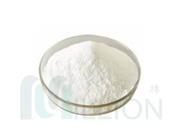General: Vortioxetine exerts an antidepressant effect mainly by increasing 5-HT concentrations in the central nervous system (CNS), has little effect on noradrenaline and dopaminergic neurons compared to other selective 5-HT reuptake inhibitors (SSRIS) or serotonin-noradrenaline reuptake inhibitors (SNRIS). Several clinical trials have shown that vortitaxine has better efficacy, safety and tolerance in the treatment of severe depression. Vortioxetine is a potent serotonin reuptake inhibitor with high affinity for 5-HT transporters in humans and little affinity for noradrenaline transporters and dopamine transporters. Vortioxetine is also a 5-HT 1 A receptor agonist, 5-HT 1 B receptor partial agonist, 5-HT 1 D, 5-HT 3 and 5-HT 7 receptor antagonist as well as a 5-HT uptake inhibitor. Vortioxetine exerts antidepressant effects in rats by acting together on these receptors.
Product introduce:Vortioxetine is a new drug for the treatment of depression, which was jointly developed by Lundbeck of Denmark and Takeda of Japan. It was approved for marketing by the US Food and Drug Administration (FDA) on September 30, 2013 under the trade name of Brintelix, and is used for the treatment of major depression (MDD).
Function:Vortioxetine is used to treat depression and anxiety. It is a low molecular weight piperazine sulfide, which is classified as an antidepressant (N06A) by the World Health Organization and a hypnotic/sedative drug (N5B), an antidepressant and an emotional stabilizer (N6A) by the drug classification system of the European Pharmaceutical Market Research Association (EPhMRA). At present, it is believed that the occurrence of depression is mainly related to the decrease of 5-HT functional activity, while the decrease of norepinefrine (NE) and dopamine (DA) functional activity is also considered to be related to the onset of depression.
Animal studies have shown that in rats, through the combined action of the above receptors, Voetixtine can increase the levels of serotonin, dopamine, noradrenalin, acetylcholine and histamine in the brain regions related to depressive episodes, and regulate the functions of γ-GABA(γ-aminobutyricacid) and glutamatergic neurons, thus playing an antidepressant role.
Origin:In October 2013, CHMP, a subsidiary of the European Medicines Agency (EMA), suggested that Vortioxetine be used to treat severe depression and issued a European marketing license, which was officially put on the European market in January 2014.
Vortioxetine exerts its antidepressant effect mainly by increasing the concentration of serotonin (5-HT) in the central nervous system (CNS). Compared with other selective serotonin reuptake inhibitors (SSRIS) or serotonin-norepinephri reuptake inhibitors (SNRIS), Vortioxetine has little effect on noepinephrine and dopaminergic neurons. A number of clinical trials have shown that vortexidine has good efficacy, safety and tolerance in the treatment of MDD.

 China
China



